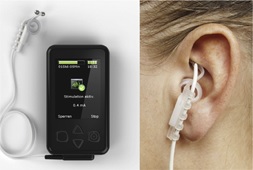Lessons learned from transcutaneous vagus nerve stimulation: Epilepsy
Kristen Sparrow • January 15, 2020


The author was kind enough to send me a copy of the full paper. The upshot was that there was no statistically significant reduction at 28 days, but there was at 20 weeks. The patients are getting hours of stim per day. I wanted to underscore this take away.
Because numerous parameters of brain stimulation therapies (e. g.
stimulation target, frequency, pulse patterns, intensity, duration)
can be adjusted within wide ranges, the “optimal” stimulation settings
remain unclear.Hence, there is a strong need for comparative
studies.
Lessons from tVNS EpiRes 2019 Hamer Bauer
Lessons learned from transcutaneous vagus nerve stimulation (tVNS).
Author information
Abstract
Transcutaneous vagus nerve stimulation (tVNS) is a newly developed method which intends to overcome the disadvantage of surgical implantation of  the stimulation device. The tVNS device is designed to stimulate the auricular branch of the vagus nerve via a bipolar electrode attached to the skin of the left ear conch. A randomized, double-blind controlled trial assessed efficacy and safety over 20 weeks of tVNS (n=39) vs. active control tVNS (n=37) in patients with drug-resistant epilepsy. While the mean seizure reduction per 28 days at end of treatment (2.9% reduction from baseline in the control group vs 23.4% in the active group) did not reach statistical significance, there was a significant reduction in seizure frequency (34 %) in patients in the tVNS group at the end of the treatment period (20 weeks). TVNS was well-tolerated. The results justify further trials with longer observation periods and possibly at earlier stages of epilepsy.
the stimulation device. The tVNS device is designed to stimulate the auricular branch of the vagus nerve via a bipolar electrode attached to the skin of the left ear conch. A randomized, double-blind controlled trial assessed efficacy and safety over 20 weeks of tVNS (n=39) vs. active control tVNS (n=37) in patients with drug-resistant epilepsy. While the mean seizure reduction per 28 days at end of treatment (2.9% reduction from baseline in the control group vs 23.4% in the active group) did not reach statistical significance, there was a significant reduction in seizure frequency (34 %) in patients in the tVNS group at the end of the treatment period (20 weeks). TVNS was well-tolerated. The results justify further trials with longer observation periods and possibly at earlier stages of epilepsy.
Copyright © 2019. Published by Elsevier B.V.
KEYWORDS:
Epilepsy; Seizures; Transcutaneous vagus nerve stimulation; Treatment

